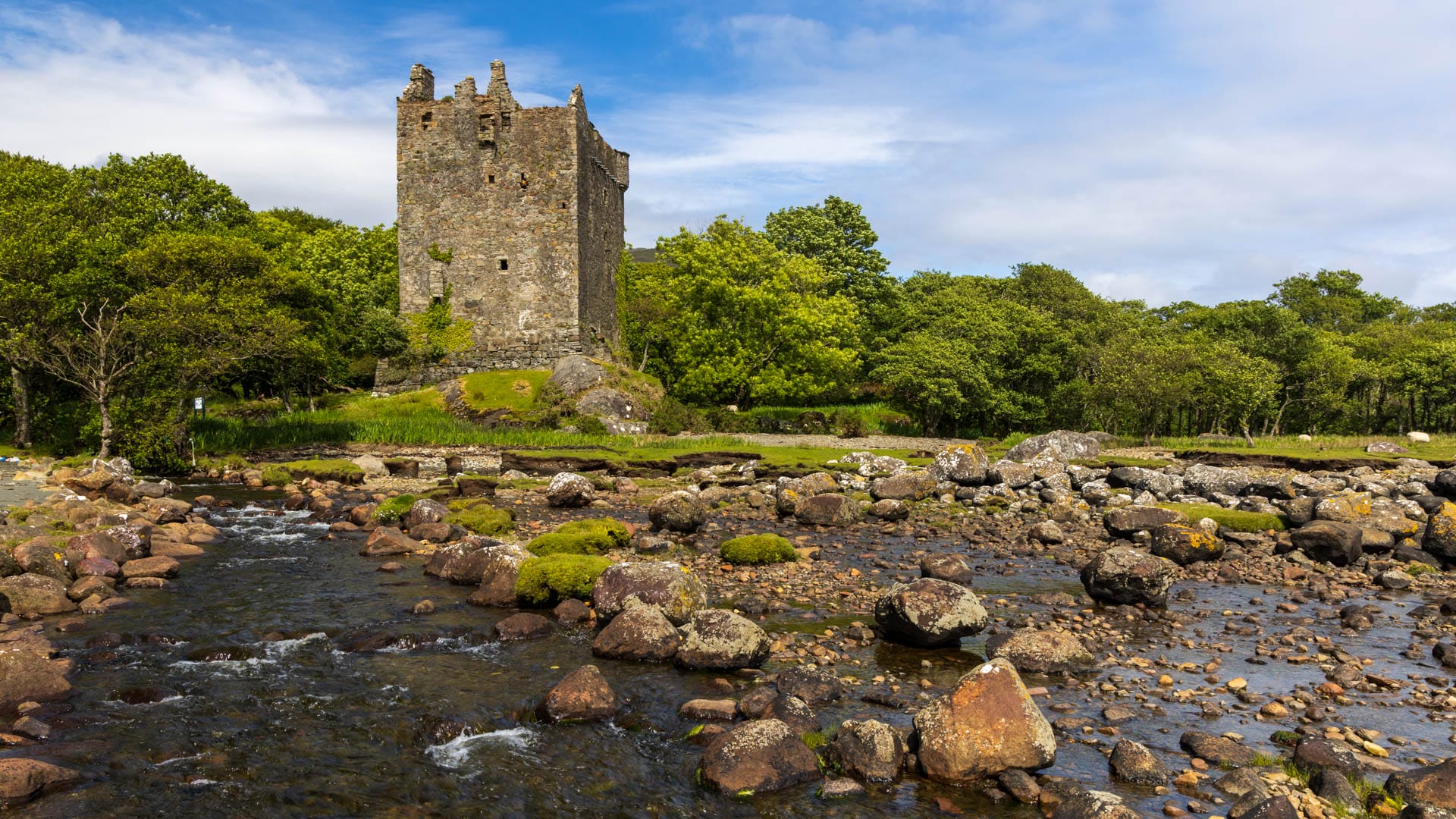The village of Lochbuie in the south of Mull is known as the green garden of the island. It is also home to an impressive castle, the only stone circle on the island and an old, small church.

At the foot of three mountains, on the shore of an arm of the sea, lies a hollow. A fertile plain has formed in it, a small paradise. It is called Lochbuie.
It is so beautiful here that people even settled here in the Neolithic Age. At least the only complete stone circle that can still be marvelled at on the Isle of Mull bears witness to this.
Over the millennia, people have repeatedly left impressive traces in Lochbuie. That’s why a visit to this beautiful corner of the Isle of Mull is worthwhile. I’ll tell you what you can see and experience there and give you some interesting background information.
Lochbuie Standing Stones
At the foot of Ben Buie lies an almost complete stone circle from the Neolithic period. Nine monoliths are grouped together here with a diameter of twelve metres. This is relatively small compared to the large representatives of stone circles in Scotland, such as those at Callanish. Nevertheless, they exude a magical atmosphere, especially with the mountain backdrop.
However, the stones can only be reached by walking through a meadow. You must pay attention to the white markings. There are already a few individual monoliths along the way. However, as you pass through pastures, there may be animals running around freely. Please always make sure that the gates are closed. The meadow is also very muddy after rain.
Access is via a driveway on the road. If there is still room here, you can park carefully at the side so that the entrance is free for agricultural vehicles.
The Old Post Office
At the end of the road to Lochbuie at the large car park is a small café called The Old Post Office. It offers travellers dishes ranging from meat and fish to veggies. And of course scones, brownies and other sweet treats. And all very tasty.
The food can be eaten outside with a view of the water. However, you should watch out for the winged feeders.
However, the café is only open between 10:00 and 15:30.
The car park, which opens up behind a small pyramid, is right next to the Old Post Office. This is a memorial to King Edward VII, who reigned at the beginning of the 20th century.
Moy Castle
From the car park, you can take the short walk to Castle Moy. It is not difficult and takes about a quarter of an hour. The path leads across meadows, through the rampant rhododendrons and along the beach.
At the end you reach Tower House, which dates back to the 15th century. Clan MacLaine, a branch of the MacLeanes from Duart Castle, once resided here. However, they abandoned the castle in 1752 and retired to the nearby manor house “Lochbuie House”.
The tower consists of three floors connected by a spiral staircase. The lower floor has a dungeon and its own spring.
Unfortunately, the castle is no longer safe inside, so it can only be admired from the outside.
St Kilda’s Church
Never annoy the lord of the manor. According to legend, MacLaine of Lochbuie wanted to teach this lesson to a vicar who always drove his ducks onto his fishing grounds. In revenge, he built St Kilda’s Church. Another story has it that he built it for his wife.
Either way, the church is a real gem and should definitely be visited from the inside. The entrance area hides a small sensation. When the foundations were excavated, the workers discovered a Celtic cross that is over 800 years old. It has now been walled in on the right-hand side of the entrance hall.
In the main room, the stained glass windows, the carved cross from Bavaria and many interesting plaques are fascinating.
Other places of interest
If you follow the path behind Moy Castle along the beach, you will reach the Caibeal Mheamhair mausoleum. This means Chapel of Remembrance. The small church was converted into a memorial for Donald MacLaine of Lochbuie in 1864. The small stained glass windows in the shape of stars in the ceiling are particularly interesting.
Between Moy Castle and the mausoleum stretches the sandy Lagan Sands. If you’re lucky, you might even spot sea eagles in the area. So keep your eyes peeled!
Finally, on the road out of Lochbuie is Kinlochspelve Church, which has stood here since 1828.
Knowledge: Lochbuie history and name
The village takes its name from the loch on whose shore it lies. The Gaelic “Loch Buidhe” means “yellow loch” – as it is written everywhere. However, they ignore the fact that Gaelic uses colours to express emotions. “Nach buidhe dhut!”, for example, means “You lucky one!” The colour yellow is therefore associated with happiness. So maybe that was a lucky hole? Fitting for such a fertile plain.
Hector MacLaine – like his brother Lachlan – received the lands from the first Lord of the Isles. Lachlan is the progenitor of the MacLean of Duart. The two branches later fought each other.
Directions
With satnav: enter “PA62 6AA” to get to Lochbuie.
Without sat nav: Whether coming from the west or east, take the A849 south until you see the sign for Lochbuie. Continue straight ahead on this road until you reach the car park in Lochbuie.